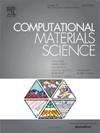Thermodynamic properties of fcc lead: A scalar and fully relativistic first principle study
IF 3.1
3区 材料科学
Q2 MATERIALS SCIENCE, MULTIDISCIPLINARY
引用次数: 0
Abstract
This study investigates the thermodynamic properties of face-centered cubic lead (fcc-Pb) using ab-initio methods within the quasi-harmonic approximation (QHA), examining the influence of spin–orbit coupling (SOC) and the exchange–correlation functionals. Two types of ultrasoft pseudopotential (US-PP) are considered: one that excludes (scalar relativistic PP) and one that includes the SOC effects (fully relativistic PP). Further, for each PP, we test the performance of three popular exchange–correlation functionals: Perdew-Burke-Ernzerhof generalized gradient approximation (PBE) (Perdew et al. Phys. Rev. Lett. 77, 3865 (1996)), PBE modified for dense solids (PBEsol) (Perdew et al. Phys. Rev. Lett. 100, 136,406 (2008)), and local density approximation (LDA) (Perdew et al. Phys. Rev. B 23, 5048 (1981)). We calculate the Helmholtz free energy, incorporating lattice vibrations (phonons) and electronic excitation contributions. The estimated equation of state (at 4 K and 301 K), phonon dispersions (at 100 K and 300 K), mode-Grüneisen parameters (γqη) (at 100 K), volume thermal expansion coefficient (β), isobaric heat capacity (CP), bulk modulus (BS), and thermodynamic average Grüneisen parameter (γ) are compared with the available experimental and theoretical studies. Moreover, the 0 K pressure-dependent elastic constant-coefficient (Cij) of fcc lead and Pugh ratio, Debye temperature, and longitudinal and transverse sound velocities for polycrystalline lead are presented. The contributions of electronic excitations in all the thermodynamic properties are found to be negligible. With increasing pressure, the role of spin–orbit effects decreases but does not vanish. Our findings demonstrate that SOC leads to results distinct from the SR approach, but agreement with the experiment is not consistently improved by including SOC.

求助全文
约1分钟内获得全文
求助全文
来源期刊

Computational Materials Science
工程技术-材料科学:综合
CiteScore
6.50
自引率
6.10%
发文量
665
审稿时长
26 days
期刊介绍:
The goal of Computational Materials Science is to report on results that provide new or unique insights into, or significantly expand our understanding of, the properties of materials or phenomena associated with their design, synthesis, processing, characterization, and utilization. To be relevant to the journal, the results should be applied or applicable to specific material systems that are discussed within the submission.
 求助内容:
求助内容: 应助结果提醒方式:
应助结果提醒方式:


